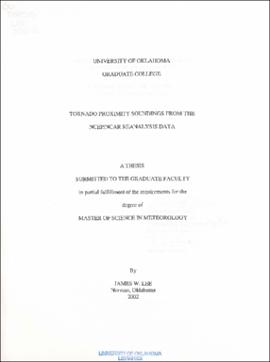| dc.contributor.author | Lee, James Wynn | |
| dc.date.accessioned | 2021-08-16T17:00:12Z | |
| dc.date.available | 2021-08-16T17:00:12Z | |
| dc.date.created | 2002 | |
| dc.date.issued | 2002 | |
| dc.identifier.uri | https://hdl.handle.net/11244/330720 | |
| dc.description | Thesis (M.S. in Metr.)--University of Oklahoma, 2002. | |
| dc.description | Includes bibliographical references (leaves 60-61). | |
| dc.description.abstract | Thermodynamic soundings have been constructed from the reanalysis dataset produced by the National Centers for Environmental Prediction (NCEP) and the National Center for Atmospheric Research (NCAR). This was done to expand the
volume, resolution, and global coverage of sounding data available for research, particularly as it pertains to severe thunderstorm environments. The reanalysis describes global, three-dimensional atmospheric fields, every six hours, for a period of more than fifty years. Soundings were constructed using a series of software packages and programs designed for this project, and were compared with corresponding observational data. Some sounding-derived parameters had values in the reanalysis that were close to those calculated from observed data, while other parameters revealed less agreement. It was concluded that some reanalysis sounding-derived parameters were similar enough to observations to be useful analysis tools. The reanalysis soundings were also examined to assess their capability to differentiate between different types of severe weather environments.
Statistical analyses indicate that the reanalysis is able to discriminate quite well in some instances. Thus, the reanalysis dataset represents a potentially significant development in the study of proximity soundings. It is reliable enough (compared to observations) for the increase in volume and resolution of data gained through its use to offset possible errors present in the reanalysis and sounding construction process. Further study of reanalysis soundings could yield more comprehensive results, and should represent a useful alternative (or supplement) to observations in many areas of research that utilize proximity soundings. | |
| dc.format.extent | viii, 61 leaves | |
| dc.format.medium | viii, 61 leaves : ill. (some col.) ; 29 cm. | |
| dc.language.iso | eng | |
| dc.subject.lcsh | National Centers for Environmental Prediction (U.S.) | |
| dc.subject.lcsh | National Center for Atmospheric Research (U.S.) | |
| dc.subject.lcsh | Tornadoes | |
| dc.subject.lcsh | Thunderstorms | |
| dc.title | Tornado proximity soundings from the NCEP/NCAR reanalysis data | |
| dc.type | Text | |
| dc.contributor.committeeMember | Richman, Michael | |
| dc.contributor.committeeMember | Crawford, Kenneth | |
| dc.contributor.committeeMember | Brooks, Harold | |
| ou.group | School of Meteorology | |
